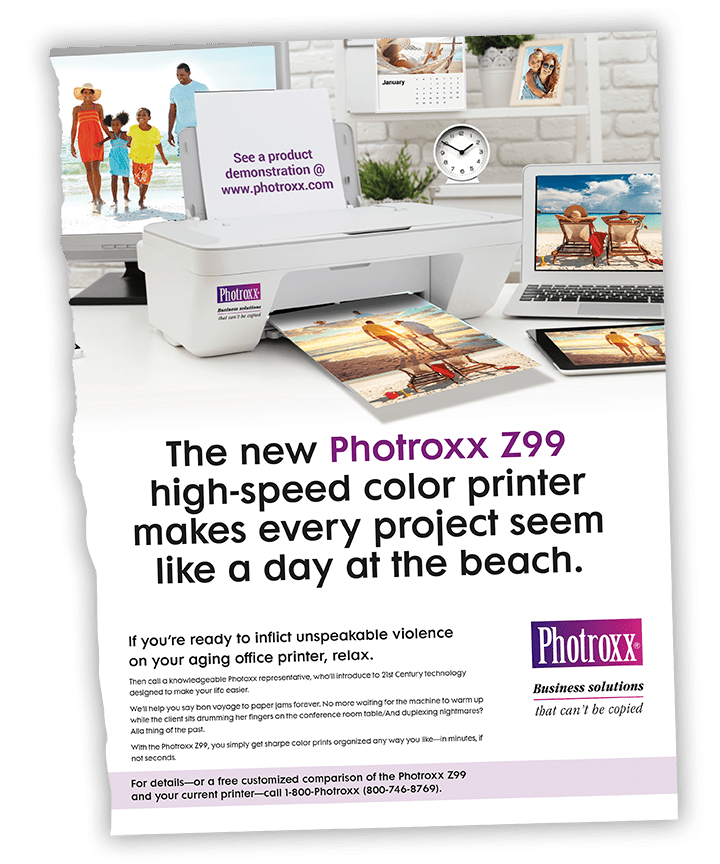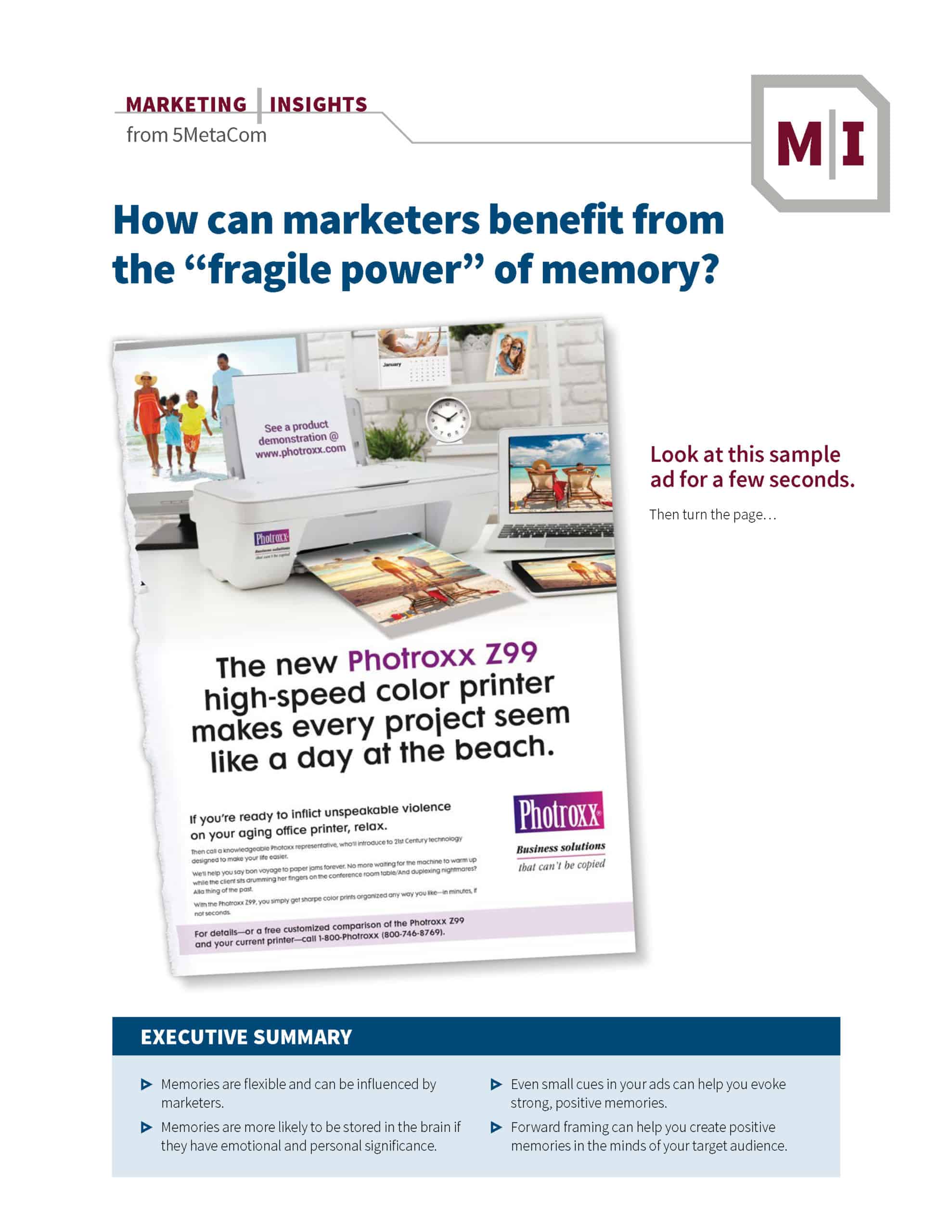How can marketers benefit from the “fragile power” of memory?

Look at this sample ad for a few seconds.
Then scroll down…
EXECUTIVE SUMMARY
- Memories are flexible and can be influenced by marketers.
- Memories are more likely to be stored in the brain if they have emotional and personal significance.
- Even small cues in your ads can help you evoke strong, positive memories.
- Forward framing can help you create positive memories in the minds of your target audience.
Do you create positive memories of your ads?
Without scrolling back up to the cover, what do you remember about the sample ad shown there?
- Did it evoke specific memories of “a day at the beach?”
- If so, were those memories recent ones—or from your childhood?
- Were they generally good or bad memories?
- Based only on what you recall, what are your impressions of the product advertised?

Perhaps you didn’t consciously retrieve memories of building sand castles in your youth or honeymooning in Hawaii. But odds are, the ad induced some memories in your brain.
According to experts from the Harvard Business School, marketers play a central role in creating consumer memories, yet many remain largely unaware of how much impact they can have on the “fragile power of memory.”1
For example, many factors increase the likelihood that ad messages will be stored in memory, including emotion and personal significance. So, the creators of the ad shown on the cover—for an imaginary company called Photroxx—are betting that “a day at the beach” will have some type of personal significance to you. (Did it?)
In addition, they hope the ad will evoke happy emotions you’ll associate, even if only subconsciously, with Photroxx. (Were they successful? How did the ad make you feel?)
How were these memories initiated? By using cues.
Using cues to evoke memories
Though we’re not consciously aware of most cues, they’re among the most influential tools marketing managers can use to evoke memories that will inspire consumers to buy.1
Interestingly, even the memories elicited by cues may also be perceived only on an unconscious level, though that doesn’t negate their influence. According to memory experts, the most powerful memories that can sway consumer behavior are often unconscious.2
For the Photroxx ad, cues—such as the beach scenes emerging from the printer and the phrase a day at the beach—might stimulate memories (conscious or unconscious) of beach vacations you’ve enjoyed throughout your life.
Furthermore, these memories—or their cues—can stimulate the recognition of other cues, however subtle, such as the calendar on the wall. As memory researchers have discovered, even seemingly trivial elements of a photograph can serve as cues for important marketing messages.
For instance, including a clock in an image of a customer at a service counter is more than twice as likely to evoke speedy service as the same image without a clock.1 Similarly, featuring a clock in the ad at the top of this web page might suggest that readers don’t have to worry about time while enjoying “a day at the beach,” and, by analogy, when using a Photroxx printer.
Even a simple ad can contain many cues. Some may resonate with the target audience and some may not. Regardless, cues help advertisers frame the memories that are created in the audience’s mind.


Cues can be valuable at any time. Memory researchers have found that adding a clock to an image of a customer at a service counter is more than twice as likely to evoke speedy service as the same image without a clock.1
Frame customer perceptions by framing their memories
Despite long-standing belief to the contrary, memories are flexible, not fixed. To paraphrase leading authorities on this subject, memories are not “snapshots” and they can be grossly inaccurate.3
Case in point: About 16% of adults who were shown an ad featuring Bugs Bunny at Disneyland® “remembered” seeing Bugs there as a child. What’s up with that, doc? Bugs Bunny is a Warner Brothers character and is never seen at Disney resorts.4 Still, these adults were confident in their memories. Why?
Memory experts now know that we store memories not as discrete units, but in chunks that the brain reassembles during retrieval. And during retrieval, a memory changes in response to cues, such as seeing a Disney ad that featured Bugs Bunny. Perhaps the adults who“remembered” seeing Bugs at Disneyland had simply retrieved separate memories but combined them into one.
Moreover, memory researchers have learned that we not only recall an experience differently depending on the triggering cue, but we’re unaware of the change.1 That is, as far as we’re concerned, our memories are always 100% accurate.
Armed with that powerful piece of knowledge, marketers can develop strategies that directly affect the memories target customers have about a product/service.5

How? Depending on the cues marketers use when discussing their products, they can create a positive memory for consumers who:
- Are unfamiliar with a product (forward framing)
- Have already tried a product (backward framing)
Through strategic use of cues, marketers can create positive memories for consumers who are unfamiliar with a product/service, a process called forward framing.
Forward-framed is forearmed
Most marketing communications focus on forward framing to influence consumer expectations about a future experience. These expectations, in turn, can alter their actual experiences and their memories of those experiences.1
For instance, one goal of the ad at the top may be to link the printer to positive (and emotional) memories of “a day at the beach.” Later, these memories could reinforce positive experiences with the printer—or help soften negative experiences—even if they do so on an unconscious level.
Forward framing can be reinforced in many ways. Photroxx sales representatives could visit prospects while wearing a Hawaiian shirt, for example. Or they could simply begin each sales call by promising to help make the customer’s workday “like a day at the beach.” The Photroxx website could also be designed with beach-themed cues. All of these things make messages more salient for customers.
Another advantage of forward framing: A head-to-head comparison in your ad can help create negative memories of a competitor’s product/service while creating positive memories of your product/service.
Which, as you may recall, helps answer the question asked at the beginning: Do you create positive memories of your ads?

Backward framing: Changing memories, changing minds
Memory researchers have discovered that a customer’s memory of prior product experiences will differ from the actual experiences if marketers refer to those experiences in positive ways. This is backward framing.
In one study, participants were served a vinegar-tinged, salty orange drink. But after seeing an ad suggesting that the drink was “refreshing,” participants remembered their taste experience as “refreshing.”6
This finding suggests that it may be possible to replace a customer’s negative memory of a product/service with a more positive one—and win a second chance to earn that customer’s loyalty.

Note: This sample ad relies heavily on “borrowed interest” (the beach theme) and was created solely to help illustrate the information presented in this brochure. It does not represent the level of high-quality, strategy-driven work typically produced by 5MetaCom’s Creative Department for the agency’s clients.
What should you remember from reading this?
If nothing else, you can benefit from storing this fact in long-term memory:
As a marketer, you can play a central role in creating— and even altering—customer memories about your product.
Here are a few things to remember when creating a marketing campaign:
- Incorporate visual and/or copy cues that are likely to:
- Prompt a positive emotional response (e.g., joy, surprise, peace of mind)
- Have personal significance to your target customer
- Suggest product/service benefits, such as speed and efficiency (even if you don’t specifically cite speed/efficiency as a benefit)
- General copy cues, such as “remember family picnics?…” are better than specific ones, such as “remember family picnics in the country when you were 11?…”
- Featuring a head-to-head comparison in your ads can help you create positive memories of your product while creating negative memories of a competitor’s product.
1 Zaltman, G. (2003). How Customers Think: Essential Insights into the Mind of the Market. Boston, MA: Harvard Business School Press.
2 Schacter, D. & Curran, T. (2000). Memory without Remembering and Remembering without Memory: Implicit and False Memories. The New Cognitive Neurosciences, 2nd ed. (pp. 829-844). Cambridge, MA: The MIT Press.
3 Schacter, D. (Ed.). (1995). Memory distortions: How minds, brains, and societies reconstruct the past (p. 22). Boston, MA: Harvard University Press.
4 Braun, K., Ellis, R., & Loftus, E. (2002). Make My Memory: How Advertising Can Change Our Memories of the Past. Psychology & Marketing, 19(1):1-23.
5 Braun, K., & Zaltman, G. (1998). Backward Framing Through Memory Reconstruction (working paper) (pp. 98-109). Marketing Science Institute.
6 Braun, K. (1999). Post-Experience Effects on Consumer Memory. Journal of Consumer Research, 25(4): 319-334.
All other product names and trademarks are the property of their respective owners.
